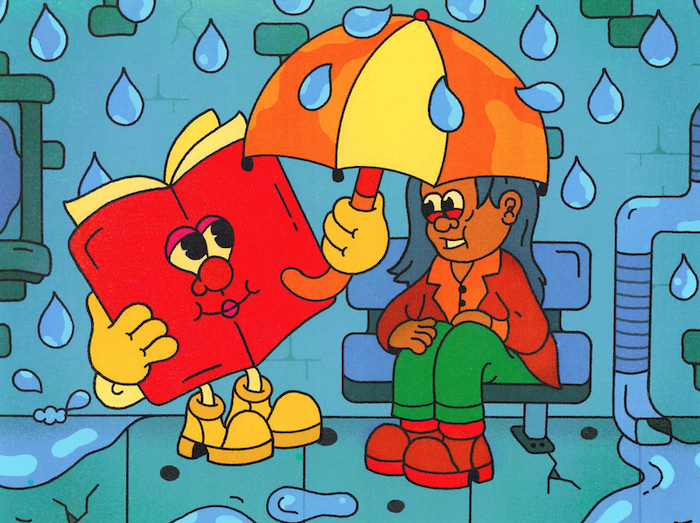— Loss can be terribly isolating, but art can be a soothing balm that helps you feel less alone.

When my beloved dog, Chuck, suddenly died at the end of 2022, I was hit with a sense of pure, uncut sadness I hadn’t experienced in a long time. Even though I knew, intellectually, that losing a pet can be devastating, I was still unprepared for how horrible I’d feel in the days, weeks, and months following his death. The good(ish) news was that it wasn’t my first grief rodeo—in fact, the end of my marriage gave me something of a playbook for coping with loss, even if that loss looked and felt quite different this time.
A big part of that playbook, for me, involves consuming works of art—essays, poems, novels, movies—that allow me to sit in my sadness. When I’m feeling really bad, I find that accepting that reality actually makes me feel less awful; it helps me remember that the only way out is through, and there’s no way to rush that process. And facing my feelings head-on by engaging with a beautifully observed piece of art helps meliorate the loneliness that goes hand-in-hand with loss. Grief can be very isolating, but art that articulates your pain and reminds you of the existence of other Sad People who understand your sadness on a cellular level can be a soothing balm in a dark time.
Since grief has been at the top of my mind lately—and because the losses of the past three years are truly staggering—I thought I’d round up some of my go-to media here. The following pieces of writing and art aren’t specifically about losing a pet, by the way; they deal with various kinds of loss. (On that note: Just a heads up that there will be mentions of miscarriage, death of a child, and death of a parent in this list.) I hope that my playbook, or parts of it, will help you or someone you love as you move through your sadness.
Articles, essays, and poems
“When Things Go Missing,” The New Yorker. This essay is hands-down the most moving and beautiful piece of writing I’ve ever read on the topic of loss and grief. It opens with writer Kathryn Schulz’s reflection on misplacing small items, and then slowly builds into a story about the death of her beloved father. It’s impossible to choose a single line to quote; it is simply a perfect piece of writing that you just have to read in full. (Schulz went on to make this essay the basis of a memoir, Lost & Found, so you may want to check that out as well.)
“Children Don’t Always Live,” The New York Times. This essay, by Pitchfork editor Jayson Greene, deals with a level of pain that most of us can’t comprehend: the sudden death of a child. (Greene also went on to author a book about this subject.) He writes about this tragic loss in a way that is equal parts straightforward and absolutely devastating. “When I realized Greta would not live, I wanted to die so purely, and so simply,” he writes. “I could feel my heart gazing up at me quizzically, asking me in between beats: ‘Are you sure you want me to keep doing this?’ But I found I could not give the order.” It’s one I’ve reread several times over the years, and it cracks me open every single time.
“I Didn’t Know What to Wear to My Brother’s Funeral,” Racked. This is a lovely and sad essay about losing a sibling in your twenties. “Preparing for my brother’s services felt like preparing for the worst high school reunion, in which I was expected to be on stage to show everyone what Sad looked like,” Katie Cunningham writes. “No one is supposed to be 25 when their brother dies. I should’ve been worrying over whether or not a dress was too slutty for his wedding, not too slutty for his wake.”
“DEAR SUGAR #44: How You Get Unstuck,” The Rumpus. In this installment of Cheryl Strayed’s beloved advice column, the Wild author responds to a letter writer who is struggling to feel okay after a miscarriage. I often think about the line “They live on Planet Earth. You live on Planet My Baby Died”—because even if you aren’t dealing with this specific type of loss, I think that feeling like you simply cannot relate to the people around you is fairly universal when you are grieving.
“For Many Widows, the Hardest Part Is Mealtime,” The New York Times. It can be surprisingly hard to feed yourself when you’re going through a difficult time. Even though losing your appetite due to stress and grief is fairly common, it’s not something I hear discussed very often. This article gives the topic the attention it deserves and touches on the groups that have sprung up to help people nourish themselves and connect socially with others. (Also, if this is resonating with you, here’s an article about easy meals to prepare when you’re sad that I wrote several years ago.)
“A Holiday Survival Guide for Sad People,” Pinch of Yum. I’ve referenced this super practical guide a lot over the years; while it’s specifically about coping during “the most wonderful time of the year,” I think it’s helpful for any occasion or time period when you’re expected to have fun and feel joyful.
“On This the 100th Anniversary of the Sinking of the Titanic, We Reconsider the Buoyancy of the Human Heart” by Laura Lamb Brown-Lavolie. I first discovered this poem in The Paris Review and just really love it. The narrator asks the Titanic for advice (“I was hoping you’d teach me how to sink, I said. You who have spent a century underwater with 1500 skeletons in your chest”), and the ship really delivers. It’s a very beautiful read, especially if you’ve recently had your heart broken.
Books, TV shows, and movies
When it comes to art for sad times, everyone’s taste is a bit different. Some people opt for laugh-out-loud comedies that help them cheer up and tune out the bad stuff; others turn to beloved favorites that provide comfort through familiarity (e.g., reruns of Friends or Buffy the Vampire Slayer). Personally, I am drawn to gentle sci-fi that deals with themes of loss, alternate universes, do-overs, and the ability to wipe certain memories. (Bonus points if it takes place in winter!)
“Story of Your Life” by Ted Chiang. This short story is the basis for the 2016 movie Arrival, and I think it’s a lot better than the film adaptation. It’s a slowly unfolding story about loss and cherishing the time you have with people; as soon as I finished it, I reread it immediately. You can find it in Chiang’s book Stories of Your Life and Others or read it here.
Station Eleven by Emily St. John Mandel. This 2015 novel, which alternates between the onset of a pandemic and its aftermath 20 years later, is a gripping read that also perfectly encapsulates the loneliness and isolation of a big loss. While the HBO show is a well-regarded adaptation, I’d still recommend reading the book, as the prose is really lovely. (“As Jeevan walked on alone he felt himself disappearing into the landscape. He was a small, insignificant thing, drifting down the shore. He had never felt so alive or so sad.”)
The Memory Police by Yōko Ogawa. This book takes place on an unnamed island where entire categories of objects start disappearing without warning or explanation, and the work of the memory police is to ensure these items stay forgotten, never to be spoken of again. While that description makes it sound like an intense dystopian thriller, it’s actually quite soft and mournful.
Severance. This gorgeously shot Apple+ series manages to be both a totally engrossing (and extremely well-paced) puzzle box and a really great meditation on work, grief, and the ways we try to compartmentalize and move on from loss. After finishing season one I immediately wanted to rewatch it—it’s that good.
Black Mirror. Each episode of Black Mirror is its own contained story, and several of them deal with loss and heartbreak. I’d recommend season one, episode three: “The Entire History of You” (breakups/divorce); season two, episode one: “Be Right Back” (death/loss); and season three, episode four: “San Junipero” (death/loss/love).
Everything Everywhere All at Once. The only thing I knew going into this movie was that it involved multiverses and would supposedly make me weep. But because it’s so absurd and laugh-out-loud funny, I found myself wondering, with 30 minutes or so left to go in the film, when I was supposed to start crying. Not long after that, my girlfriend and I both found ourselves fully sobbing—like, tears streaming down our faces. If you lean toward the fun/distracting stuff when you’re grieving, but also want some emotional release, I can’t recommend it enough.
Inception. Perhaps you saw this movie when it came out in 2010 and don’t recall it feeling very grief-y; if that’s the case, I would definitely encourage you to revisit it. On rewatch, the complex plot becomes easier to follow, so you can focus on the story, which is about corporate espionage, sure, but also about coping with loss. If your grief has made your life feel completely surreal or like a nightmare you can’t wake up from, definitely add this one to your queue.
Eternal Sunshine of the Spotless Mind. This was my go-to “I’m really sad” movie for years, and while other, newer, offerings have slowly taken over the top spot, I will always have a special place in my heart for it. It checks all my boxes (heartbreak, do-overs, wiped memories, snow) and gets extra points for starring Kate Winslet.
You’re not alone in this, and you won’t feel this way forever. Until then, I’ll be thinking of you.
Complete Article ↪HERE↩!

